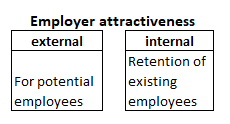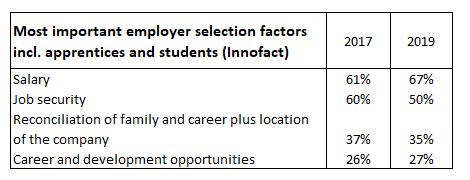Last Updated on March 12, 2024 by Lukas Rieder
Employer Attractiveness
Employer attractiveness is understood as an organization’s power to attract applicants for positions to be filled and to retain key employees. As a result, a distinction must be made between external and internal employer attractiveness. The factors that make a company appear interesting to potential employees generate external employer attractiveness. Factors that promote the loyalty of existing employees are elements of internal employer attractiveness.

External Employer Attractiveness
In an online survey in early 2022 by Randstad Employer Brand Research of 3,727 employees and job seekers aged 18 – 65 in Germany, respondents were asked about the five most important factors to them. The results, with comparable results from 2016 and 2101, are indicated below.

The change over time shows that while there are minor shifts in rank, partly caused by the COVID pandemic, the top 5 attractiveness factors remain the same.
Other surveys show the same five attractiveness factors as most important. For example, the opinion research institute Innofact AG conducted in May 2019 an online survey of 1,006 employees as well as apprentices and students representative for the German population. The survey produced the following ranking: Employer factors for students and apprentices
Employer factors for students and apprentices
Attractive employers for career starters
In 2015 https://berufsstart.de investigated which characteristics companies should have to be perceived as an attractive employer by students, including graduates as well as young professionals.
In that study, in addition to the so-called hard, primary factors, the soft characteristics – the secondary features for the popularity of employers were determined for the first time. It was found that among the hard factors, opportunities for further training (88%) and opportunities for promotion (79.5%) enjoy the highest priority when choosing a suitable employer. For three quarters of all participants, the image of a company is the third most important factor. International orientation and job security are also given high priority.
Social benefits and infrastructure are rated by career starters as rather insignificant for employer attractiveness. Among the desired secondary features, the working atmosphere was considered with 91.2% the most important “soft” factor for the attractiveness of companies. Working atmosphere is always an essential basis for employee satisfaction and collegial cooperation. Varied activities (76.7%) as well as work-life balance and responsibility were almost equally important. For one-third of the career starters, family friendliness was a key reason for preferring a company. Less important for the choice of company were “flat hierarchies, benefits and leisure activities”.
Source (22.05.2022): https://zvoove.com/blog/was-bewerber-bei-unternehmen-schaetzen-die-attraktivsten-arbeitgeber-2015-studie-berufsstart-de
Main factors for employee recruitment
From the rankings and assessment priorities shown, a catalog of the ten most important aspects of external employer attractiveness can be derived. Without claiming to be exhaustive, the catalog is structured here according to the dimensions of AMPLE:
Working conditions
-
-
- Leadership behavior and processes
- Promotion and career opportunities
- Acceptable workload / flexible working hours
- Work-life balance, family and career
- Attractive location (commuting, buildings)
-
Profitability and Liquidity
6. Competitive compensation and benefits
7. Profitability and financial stability of the company
Evolution
8. Challenging employment, further training opportunities
Market position
9. Good products and services of the company
10. Good reputation of the employer
It is thus understandable that job offers (print or electronic media) should include information on these 10 attractiveness factors. Interested parties should be encouraged to ask more in-depth questions about these factors during interviews. The relevant documentation will probably mostly be prepared by the HR-department, but the points mentioned should also be addressed in the direct discussions between applicants and future superiors.
Internal Employer Attractiveness
It pays to do more for your own attractiveness as an employer!
The Institute for Leadership and Human Resource Management (IFPM) at the University of St. Gallen / Switzerland conducted extensive surveys and studies on internal employer attractiveness in 2015 and 2021 (this Top Job Trend Study can be downloaded at Trendstudie Arbeitgeberattraktivität (topjob.de). In 2021, 13,400 employees from about 100 companies of various industries and sizes were surveyed, 61% of whom were male. 20% of respondents were managers. 92% of the respondents were born between 1950 and 1996 (Baby Boomer, X and Y generations).
Qualitative comparisons between companies with high and low measured employer attractiveness were obtained by interviewing the executives. It was found that the group of companies with high employer attractiveness scored around a quarter better in terms of sales growth and employee innovation ideas generated. The proportion of employees’ productive working time was around 20% higher and the ROI achieved was also around 20% higher compared with the companies with low employer attractiveness.
Factors of internal employer attractiveness
When examining factors to increase internal attractiveness, it should first be noted that all employees perceive their reality subjectively and that emotional and action-related factors often have an unconscious effect.
Therefore, it is difficult to define universally valid catalogs of attractiveness-enhancing actions. However, many positively impacting behaviors can be derived from the literature and especially from comments made in interviews about the choice of the most attractive employers. From the presented empirical analyses above we derive the ten most important internal attractiveness factors (see also https://qualitrain.net):
-
- Management style and feedback culture of superiors
- Measurably formulated objectives to be achieved and explanation of their significance
- Degrees of freedom in implementation
- Measurement/assessment of achieved results (target-performance comparison) including verbal and written recognition
- Learning opportunities at the workplace
- Further training offers, also with regard to soft skills for interpersonal interaction
- Career opportunities within the company
- Work at home
- Reconciliation of work and family care
- Joint activities (where people meet and exchange ideas).
These factors are – according to the cited IFPM-survey – not really time-dependent. In our opinion, they represent the needs of employees that need to be met so that they feel comfortable in the company and want to engage themselves to achieve the company’s goals.
This requires that all managers, from top management to cost center or team leaders
-
- regularly explain the corporate goals and the strategic objectives for each business unit,
- agree on the annual objectives so that they know which results are important,
- discuss the achievement of objectives at least twice a year and, if necessary, agree on corrective measures,
- acknowledge and thank employees for the results achieved in the past months and the efforts made to achieve them,
- take up the suggestions for improvement from the meetings and assess their feasibility or initiate their implementation, and
- take up and process the comments of the interviewed persons concerning internal cooperation.
The main factors of internal employer attractiveness are thus mainly realized through the performance of people-related management tasks.
The financial compensation for work performed is still the most important and most easily comparable decision-making factor in all employee generations (from the baby boomers, birth years 1950-1964, to Generation Z, birth years 1996-2010) (see above).
